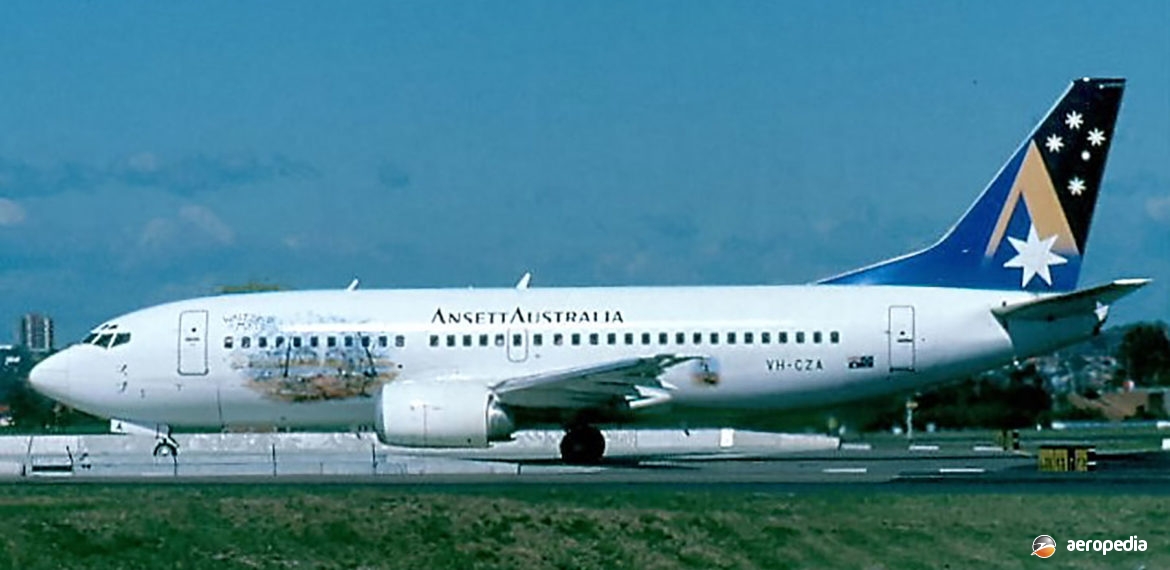Photograph:
Boeing 737-376 VH-CZA (c/n 23653) at Sydney’s Kingsford Smith Airport at Mascot, NSW in December 1995 (David C Eyre)
Country of origin:
United States of America
Description:
Commercial airliner
Power Plant:
Two 20,000 lbst General Electric CFM56-3-B1 turbofans
Specifications:
- Wingspan: 28.9 m (94 ft 9 in)
- Length: 33.4 m (109 ft 7 in)
- Height: 11.12 m (36 ft 6 in)
- Wing area: 91.02 m² (980 sq ft)
- Max cruising speed at 7,620 m (25,000 ft): 899 km/h (558 mph)
- Economical cruising speed at 10,670 m (35,000 ft): 787 km/h (489 mph)
- Range cruising at 10,670 m (35,000 ft): 797 km/h (495 mph)
- Range with max payload and no reserve: 4,225 km (2,625 miles)
- Range at economical cruising speed with max fuel and 13,245 kg (29,200 lb) payload: 5,485 km (3,410 miles)
- Empty weight: 31,561 kg (69,580 lb)
- Max payload: 16,067 kg (35,420 lb)
- Loaded weight: 61,236 kg (135,000 lb)
History:
Next variant of the Boeing 737 series built was the Model 737-300, designed to take advantage of more efficient engines and to be able to carry more passengers. Visually similar to the two previous models, this aircraft had the span increased by 1.8 m (6 ft) and there were small wing-tip extensions with mass balance probes. The cargo hold was enlarged to 30.25 m³ (1,050 cub ft) and up to an additional 20 passengers could be carried. The Model 737-300 offered better fuel efficiency, quietness and economics, these benefits being gained by use of new-generation CFM56 engines.
The first Model 737-300 was flown on 24 February 1984 and customer deliveries began in November 1984. At least 1,100 Model 737-300s were built. Accommodation was provided for a flight crew of two and up to 141 passengers in six-abreast seating.
Boeing announced it was developing the 737-300 series in March 1981, this new variant being basically a lengthened Model 737-200 but at that time the company decided to install the CFM International CFM56 high bypass turbofans on the new aircraft, this reducing fuel consumption, and also complying with future International Civil Aviation Organisation Stage 3 noise limits. The fuselage had a 2.64 m (104 in) lengthening but, despite this, there was still an 80 per cent commonality with the former model and the same ground equipment could be used.
Air New Zealand operated a number of Model 737-300s, comprising ZK-NGA (c/n 28873), ZK-NGB (c/n 29140), ZK-NGC (c/n 29189), and ZK-NQC (c/n 29189).
Australian Airlines (formerly TAA, later Qantas) obtained 12 examples of the Model 737-376 and these became VH-TAF (c/n 23477), VH-TAG (c/n 23478), VH-TAH (c/n 23479), VH-TAI (c/n 23483), VH-TAJ (c/n 23484), VH-TAK (c/n 23484), VH-TAU (c/n 23486), VH-TAV (c/n 23487), VH-TAW (c/n (23488), VH-TAX (c/n 23489), VH-TAY (c/n 23490) and VH-TAZ (c/n 23491).
Ansett Airlines followed with an order for 12 examples, these being Model 737-377s which became VH-CZA (c/n 23653), VH-CZB (c/n 23654), VH-CZC (c/n 23655), VH-CZD (c/n 23656), VH-CZE (c/n 23657), VH-CZF (c/n 23658), VH-CZG (c/n 23659), VH-CZH (c/n 23660), VH-CZI (c/n 23661), VH-CZJ (c/n 23662), VH-CZK (c/n 23663) and VH-CZL (c/n 23664).
First example to arrive was VH-TAG on 4 August 1986 for Australian Airlines, and the first for Ansett Airlines was VH-CZA on 25 August 1986. As the Model 737-300s entered service, the Model 737-200s were exported overseas. By late 2005 most of the early generation Boeing 737s in Australia had been retired and replaced, and the type was also being replaced by newer aircraft by Air New Zealand.
Freedom Air and Kiwi International Airlines also operated the Boeing 737 series in this region, the former airline operating N371TA, a Model 737-3S1 (c/n 24834) on lease from TACA International Airlines of El Salvador from April 1996 to April 1997, and ZK-FDM, a Model 737-3M8 (c/n 25016) under a five years lease from the GAP Group, this lease ending in April 2002.
Kiwi International Airlines operated TF-ABK, a Model 737-3YO (c/n 23922), on lease from GE Capital Corporation from June 1996, the aircraft being based at Christchurch, NZ. The aircraft returned to Europe after the collapse of the airline.
The Government of the Republic of Nauru has also has operated the Model 737, in 2007 operating Model 737-3YO VH-INU (c/n 23684) and which was a regular visitor to Sydney, NSW. Another operator of the type in this region was Nauru Air Corp of Brisbane, QLD, its aircraft, a Model 737-3U3, becoming VH-ONU (c/n 28732) on 22 August 2014 and it being owned by Aircraft Leasing Holding Corporation of Balwyn, VIC.
By mid 2016 Nauru Airlines operated four Boeing 737-300 passenger aircraft and one Model 737-400 freighter and had an extensive network around the Pacific providing easier access to Australia and New Zealand from the central Pacific. The company was managed from Brisbane and has its own hangar at Eagle Farm. The airline’s revenue was split 50-50 between scheduled services and charter work. It commenced services as Air Nauru but in 2006 became Our Airline before becoming Nauru Airlines in 2014.
Air Pacific operated the Model 737-5YO from Fiji with DQ-FJB (c/n 26067) ‘Island of Taveuni’, the aircraft later becoming VP-BFB.
Late in 2007 Qantas still had four Model 737-376s in service, these being VH-XMB (c/n 23478 – ex VH-TAG), VH-XML (c/n 23486 – ex VH-TAU), VH-XMO (c/n 23488 – ex VH-TAW) and VH-XMR (c/n 23490 – ex VH-TAY), all being in service since 1986 and, after having their registrations changed, being converted to freight configuration.
Boeing 737-319 ZK-NGJ (ex N1787B) was built for Air New Zealand, being handed over on 17 December 1999, and was retired on 10 August 2015, being then flown to Cairns, QLD in September that year where it became VH-XNU and was registered to Sunco Pty Ltd Holding Inc of Brisbane, entering service with Nauru Airlines. On 6 February 2023 a converted 737-300 (tanker 139) of Coulson, a fire bomber, crashed and was destroyed near Ravensthorpe, WA whilst fire bombing.

